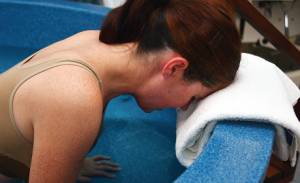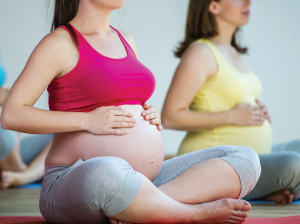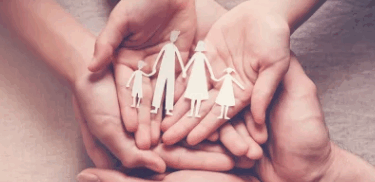Natural childbirth in at-home births are happening more with COVID causing typical hospital births to be more restrictive. No matter which road you choose, you can still have a natural birth — meaning no drugs for pain relief — whether you’re in a hospital or at home, both with similar experiences.
According to Brie Hammer, CPM, Women’s Wisdom Midwifery, private home birth midwifery practice in Cincinnati, there’s been an increase in families wanting an at-home birth rather than a hospital birth.
“There was a surge of people switching to home birth last March/April,” says Hammer. “From that point on, we’ve had a pretty steady client flow. The threat of contacting COVID-19 while birthing in hospital was responsible for the initial wave of people transferring into home birth.”
Some current hospital restrictions include prohibiting doulas from accompanying laboring people into the hospital, allowing only one support person, mask-wearing for the partner and Mom (except for during active labor) etc. To some expecting mamas, this takes away from the anticipated natural birthing experience, so they turned to at-home births.
Since many local hospitals do have the capabilities of making a natural birth environment as close to home as possible, regardless of COVID-19 restrictions, there are benefits to both.
Natural childbirth at home
If you are leaning toward an at-home birth, the first step is to be sure your home is safe for you. Consider this: Are you low-risk and having a healthy pregnancy? Do you want to share your experience with friends and family? Do you hope to avoid episiotomy, cesarean section, epidural and other interventions? If your pregnancy is considered high-risk, you are pregnant with multiples, you have had a C-section birth before, Baby is breech, you have maternal medical conditions such as high blood pressure and gestational diabetes or you are experiencing high-risk fetal issues. In this case, an at-home birth may not be safe and you should consult with your OB/Gyn to weigh your options. If you’re healthy and in the clear, it’s a go!
Using a Doula or Midwife
First things first – to find a certified professional midwife (CPM), an OB/Gyn on speed dial and a doula you trust and adore. Do your research and ask around for referrals. Also consider asking other moms about their positive birthing experience and what worked best for them. Finding a home birth midwife and a doula who is experienced in home birth and comfortable attending births outside of the hospital, is a must.
“I recommend meeting with several doulas and finding one you feel comfortable with,” Hammer suggests. “What many parents don’t realize is that your OB will not be with you during your labor! This comes as a shock to most first-time parents. You will spend your labor with your doula and one or more nurses.”
The difference between a midwife and doula? A doula does not provide medical care and is only there for physical and emotional support, and as for midwives, there are a few terms that fall under that umbrella; certified nurse midwives (CNMs) provide clinical care during your pregnancy, labor and postpartum, and CPM’s are certified in CPR and NRP (neonatal resuscitation) and can not offer pain medication. You can find a list of fantastic midwives through the Cincinnati Homebirth Collaborative on Facebook, or research local midwives who have their own personal websites, according to Hammer.
It’s important to know the difference between a certified professional midwife (CPM) and a CNM – there are no “certified midwives” in Ohio, and a CPM, is not a licensed medical provider. Licensing is only available for CPMs in Kentucky, and not Ohio. Also, a CPM can not practice in hospital.
Take a childbirth class
A home birth is a unique experience, so taking a childbirth class specific to home birth can help prepare you for what’s ahead. Luckily, many childbirth educators are offering virtual classes during this difficult time, says Hammer.
“When planning for a natural birth, preparation is essential!” she continues. “Hypnobabies is also a popular option and is a home-study course.”
Create a childbirth plan
What’s next? It’s time to make a birth plan with your birthing team and provide them with a copy, too. A well laid-out birthing plan consists of what you want your experience to be and it is what you are choosing to say, “Yes” to or what you are choosing to say, “No” to. This confirms that you have gone over everything, and everyone is on the same page so you can focus on your birthing experience. Think: Lighting, music, pillows, yoga mat, birth balls, birth supplies, hot packs, ice chips, nourishment, showers, water birth pools and of course an emergency plan. You can order your own birth tub if a water birth is in your plan, or you can rent one from many of the local midwives, says Hammer. All rented birth tubs and equipment are sanitized and liners are used. In addition to what they already carry, most midwives will provide you with a link to order a birth kit specific to their practice’s preferences.
“When we come to your birth, we have everything with us that would be available at a free-standing birth center,” she says.
Sanitizing your home is not necessary, as long as it’s comfortable and your midwife has room to set up needed supplies – they will handle the rest from there!
Emergencies and post-pregnancy
Even the healthiest pregnancies can have complications, and because of that, a good home birth midwife will not hesitate to get you to the hospital, if needed.
“If you become high risk during your pregnancy or labor, it is safest to give birth in the hospital,” assures Hammer. “There is no such thing as a CPM who attends high-risk births at home. That is not safe.”
Getting you and your Baby to the safest place is the number one priority. CPMs are specifically trained in out of hospital births including out-of hospital birth emergencies such as hemorrhage, shoulder dystocia, etc. It’s good to know that most transports that occur during labor are non-emergent (Mom requests pain medication, needs fluids, etc). As part of your plan, an “Emergency Care Plan” will be established to determine which hospital is closest if transport is needed.
“Most labor transports are for exhaustion and requests for pain relief,” says Hammer. “When vetting midwives, look for someone who does not claim to have the lowest transport rate. Realistically, you want to find someone who can identify issues appropriately, and is confident getting you to the safest place for your baby to be born.”
Although CPMs are qualified to care for healthy babies in the first six weeks of life, it’s recommended to have a pediatrician supportive of your home birth lined up to follow up with at least 24 hours afterbirth.
Natural hospital birth
No matter the current restrictions, many local hospitals will go above and beyond to meet your natural birthing needs. Although some hospitals currently prohibit doulas from accompanying the support person or if you know you would want to have your partner or spouse with you as your “plus one,” there are doula’s offering virtual support packages that include Facetime and Zoom.
“Some things may look different during this pandemic, but your support will be the same,” says Charissa Newton, DNP, APRN, certified nurse midwife at Premier Health’s Center for Women’s Health and Wellness.
Check with your doctor and stay up-to-date on current visitor guidelines, as they are ever-changing during the pandemic.
What to expect
Right now, you can expect the hospital staff to wear the appropriate personal protective equipment and visitors must wear masks as well. In addition, hospitals are continuing to use the appropriate cleaning and sanitizing procedures in between patients, according to Newton. For your natural birthing needs, many local hospitals have everything you need. Atrium Medical Center’s Natural Beginnings Birth Center, for example, offers a home-like environment with large spacious rooms, queen size beds and jacuzzi tubs. Expect everything from blow up birthing tubs and waterproof telemetry monitoring to give you the free-to-move feeling during labor and birth.
It’s comforting to know you can expect immense support with massages, breathing, relaxation music, aromatherapy and many birthing balls of different shapes and sizes, says Newton.
Hospital birth plan
Just like an at-home birth, hospital births need a plan. Communicate to your midwife, OB/Gyn and provider what natural birthing needs you would like included.
“Most importantly, review this plan with your provider and have the provider sign the bottom so the nursing staff knows they approve of your preferences,” says Hammer.
Also similar to birthing at home, you can draft up a birth plan that outlines what you feel is important during labor and birth as well as anything you think will help you commit to your plan. Newton says it’s helpful to make a music playlist in advance, practice massage techniques, labor positions, and think of comfort items you may want with you during labor.
“They may bring this initial plan to their appointment and start discussion with their provider, to answer any questions and finalize a reasonable plan that includes preferences for comfort management and options available at their birth place,” she continues. “If you don’t know where to start on a birth plan, talk with your midwife first and ask what is already available and what the team will offer for support.”
Birthing classes
Of course, hospitals provide important birthing classes, too. For a natural birth, lean toward natural labor and birth classes; some hospitals are offering online classes in lieu of the pandemic.
“These classes can show ideas for comfort measures, how to prepare for labor, what to bring, and how the support person can be the most helpful,” says Newton.
All-in-all, your natural birth plan should be what’s best for you, your baby and family. No matter what, there are benefits and risks to both a hospital and an at-home birth. Talk to your provider and ask questions about what their birthing place has to offer, and decide what is best for you.
“What is important is that the parents feel they are in the safest place possible for them and their baby and those determining factors look different from family to family,” says Hammer.






